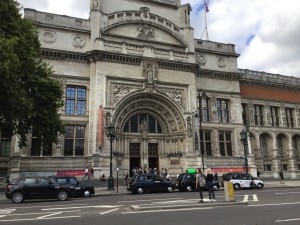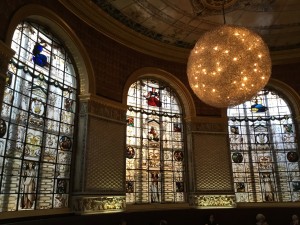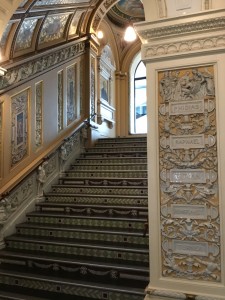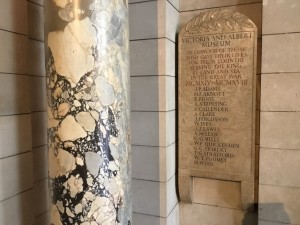
The Victoria and Albert Museum, Kensington, London.
(P. Ferguson image, August 2018)
Thread Eleven
The entrance way of the Victoria and Albert Museum is crowded with visitors this August day, anxious to make their way towards their interests and expectations. Throughout the structure countless, precious items are exhibited. Cameras focus and snap on specific items, some objects hold visitors for lengthy terms while others are passed by in favour of something else.

Detail of the Refreshment Rooms, Victoria and Albert Museum.
(P. Ferguson image, August 2018)
We have returned here this day to enjoy tea and cakes in the Refreshments Rooms, part of the elder museum that I enjoy. It is here I can sit and imagine the visitors and staff, of former times, who have sat here to become refreshed. A chance to pause within the history. This day I have come here especially for the building’s ornamentations in situ, not within exhibition cases but part of the built structure itself.

The details we have come to see. The Victoria and Albert Museum.
(P. Ferguson image, August 2018)
We have returned to this entry way of world culture to a record of local names passed by in favour of the world alluring. Here amongst the seekers is the Great War Memorial to the staff of the Victoria and Albert Museum who did not return from that conflict. Set up by subscription of the whole staff in memory of their comrades 1920.
When the world stands before us…remember them well.

The Great War Memorial to the staff of the Victoria and Albert Museum.
(P. Ferguson image, August 2018)
The Victoria and Albert Museum Great War Memorial
J.P. Adams
H.F. Arnott
E. Biggs
A.A. Bunting
I. Callender
A. Clark
J. Fergusson
W. Ives
J.J. Lawes
A. McLean
C.G. Mills
W.F. Quickenden
G.C. Siordet
T.G. Stratford
W.T. Toomey
H. Wyer
——-SNIP——-
Tags: Victoria and Albert Great War Memorial, Victoria and Albert Museum
This entry was posted by pferguson
on Wednesday, August 15th, 2018 at 11:19 am and is filed under Remember Them Well.
You can follow any responses to this entry through the RSS 2.0 feed.
You can leave a response, or trackback from your own site.
About The Author

Paul has worked with the Paradigm Motion Picture Company since 2009 as producer, historian and research specialist. Paul first met Casey and Ian WIlliams of Paradigm in April 2007 at Ieper (Ypres), Belgium when ceremonies were being held for the re-dedication of the Vimy Memorial, France.
Paul's sensitivity to film was developed at an early age seeing his first films at RCAF Zweibrucken, Germany and Sardinia. Paul returned to Canada in 1967 and was captivated by David Lean's "Lawrence of Arabia" and "Bridge on the River Kwai". Over time Paul became increasingly interested in storytelling, content development, character, direction, cinematography, narration and soundtracks.
At the University of Victoria, Paul studied and compared Japanese and Australian film and became interested in Australian film maker Peter Weir and his film "Gallipoli" (1981). Paul was inspired when he learned Weir visited the beaches, ridges and ravines of the peninsula. "Gallipoli", the film, led Paul on many journeys to sites of conflict in England, France, Belgium, Holland, Germany, Malta, Hawaii, Gallipoli, North Macedonia and Salonika.
When Paul first watched documentary filmmaker Ken Burns, "The Civil War", Paul understood how his own experience and insight could be effective and perhaps influential in film-making. Combining his knowledge of Museums and Archives, exhibitions and idea strategies with his film interests was a natural progression.
Paul thinks like a film-maker. His passion for history and storytelling brings to Paradigm an eye (and ear) to the keen and sensitive interests of; content development, the understanding of successful and relational use of collections, imagery and voice. Like Paul's favorite actor, Peter O'Toole, Paul believes in the adage “To deepen not broaden.”
While on this path Paul always remembers his grandmother whose father did not return from the Great War and how his loss shaped her life and how her experience continues to guide him.





Comments